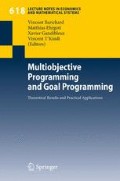Abstract
In recent years there have been considerable advances in methodology (exact and heuristic algorithms) to solve multiobjective optimization problems. Combined with the rapid improvement in computing technology, this means that large scale multiobjective optimization problems arising in real world applications have become tractable.
In this paper, I outline some application areas and illustrate how the application of multiple objective methods provide secondary benefits such as additional insight in the application area and improved processes. These benefits are in addition to the primary benefits of more realistic modelling and better decision support by including the conflicting goals that decision makers usually face.
However, the study of real world applications also motivates research on the mathematical aspects of multiobjective optimization. I illustrate this win—win situation using examples drawn from finance (portfolio optimization), transportation (train timetabling, airline crew scheduling), medicine (radiotherapy treatment planning), and telecommunication (routing in networks).
Access this chapter
Tax calculation will be finalised at checkout
Purchases are for personal use only
Preview
Unable to display preview. Download preview PDF.
References
Benson H (1998) An outer approximation algorithm for generating all efficient extreme points in the outcome set of a multiple objective linear programming problem. J Global Optim 13(1):1–24
Butchers E, Day P, Goldie A, Miller S, Meyer J, Ryan D, Scott A, Wallace C (2001) Optimised crew scheduling at Air New Zealand. Interfaces 31(1):30–56
Chang T, Meade N, Beasley J, Sharaiha Y (2000) Heuristics for cardinality constrained portfolio optimisation. Comput Oper Res 27:1271–1302
Cotrutz C, Lahanas M, Kappas C, Baltas D (2001) A multiobjective gradient-based dose optimization algorithm for external beam conformal radiotherapy. Phys Med Biol 46:2161–2175
Ehrgott M (2005) Multicriteria optimization, 2nd edn. Springer, Berlin
Ehrgott M, Ryan D (2002) Constructing robust crew schedules with bicriteria optimization. J Multicrit Decision Anal 11:139–150
Ehrgott M, Ryan D (2003) The method of elastic constraints for multiobjective combinatorial optimization and its application in airline crew scheduling. In: Tanino T, Tanaka T, Inuiguchi M (eds) Multi-objective programming and goal-programming. Springer, Berlin, pp 117–122
Ehrgott M, Klamroth K, Schwehm C (2004) An MCDM approach to portfolio optimization. Eur J Oper Res 155:752–770
Figueira J, Greco S, Ehrgott M (eds) (2005) Multiple Criteria Decision Analysis: State of the Art Surveys, vol 78 of Springer's International Series in Operations Research and Management Science. Springer Science and Business Media, New York
Gandibleux X, Beugnies F, Randriamasy S (2006) Martins' algorithm revisited for multiob-jective shortest path problems with a maxmin cost function. 4OR 4:47–59
Hansen P (1979) Bicriterion path problems. In: Fandel G, Gal T (eds) Multiple Criteria decision making theory and application, vol 177 of Lecture Notes in Economics and Mathematical Systems. Springer, Berlin, pp 109–127
Holder A (2003) Designing radiotherapy plans with elastic constraints and interior point methods. Health Care Manage Sci 6:5–1
Konno H (1990) Piecewise linear risk function and portfolio optimization. J Oper Res Soc Jpn 33:139–156
Küfer K-H, Hamacher H (2000) A multicriteria optimization approach for inverse radiotherapy planning. In: Schlegel W, Bortfeld T (eds) XIIIth International Conference on the Use of Computers in Radiation Therapy. Springer, Berlin, pp 26–28
Lahanas M, Schreibmann E, Baltas D (2003) Multiobjective inverse planning for intensity modulated radiotherapy with constraint-free gradient-based optimization algorithms. Phys Med Biol 48:2843–2871
Markowitz H (1952) Portfolio selection. J Finance 7:77–91
Martins E (1984) On a multicriteria shortest path problem. Eur J Oper Res 16:236–245
Müller-Hannemann M, Weihe K (2006) On the cardinality of the Pareto set in bicriteria shortest path problems. Ann Oper Res 147:269–286
Raith A, Ehrgott M (2008) A comparison of solution strategies for biobjective shortest path problems. Computers & Operations Research doi 10.1016/j.cor.2008.02.002
Romeijn H, Dempsey J, Li J (2004) A unifying framework for multi-criteria fluence map optimization models. Phys Med Biol 49:1991–2013
Shao L, Ehrgott M (2008) Approximately solving multiobjective linear programmes in objective space and an application in radiotherapy treatment planning. Mathematical Methods of Operations Research 68:257–276
Steuer R, Qi Y, Hirschberger M (2007) Suitable-portfolio investors, nondominated frontier sensitivity, the effect of multiple objectives on standard portfolio selection. Ann Oper Res 152:297–317
Tam B (2004) Multi-criteria methods for unit crewing in the airline tour-of-duty planning problem. In: Ehrgott M (ed) Proceedings of the 39th Annual Conference of the Operational Research Society of New Zealand. pp 174–183 Available online at http://www.orsnz.org. nz/conf39/Papers/TamB.pdf.
Weide O, Ryan D, Ehrgott M (2007) Iterative airline scheduling. Technical Report 645, Department of Engineering Science, The University of Auckland, New Zealand
Yen J, Birge J (2006) A stochastic programming approach to the airline crew scheduling problem. Transport Sci 40(1):3–14
Author information
Authors and Affiliations
Editor information
Editors and Affiliations
Rights and permissions
Copyright information
© 2009 Springer-Verlag Berlin Heidelberg
About this paper
Cite this paper
Ehrgott, M. (2009). Multiobjective (Combinatorial) Optimisation—Some Thoughts on Applications. In: Barichard, V., Ehrgott, M., Gandibleux, X., T'Kindt, V. (eds) Multiobjective Programming and Goal Programming. Lecture Notes in Economics and Mathematical Systems, vol 618. Springer, Berlin, Heidelberg. https://doi.org/10.1007/978-3-540-85646-7_25
Download citation
DOI: https://doi.org/10.1007/978-3-540-85646-7_25
Publisher Name: Springer, Berlin, Heidelberg
Print ISBN: 978-3-540-85645-0
Online ISBN: 978-3-540-85646-7
eBook Packages: Business and EconomicsBusiness and Management (R0)

